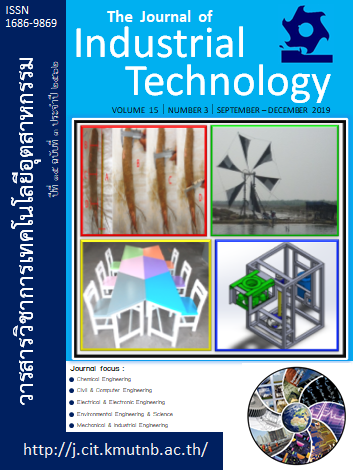(Design and Construction of a Cassava Tuber Knife Peeling Unit)
Keywords:
Cassava tuber, Knife and PeelingAbstract
Abstract
Peeling of cassava tubers is one of the important steps in processing of cassava chips. The peeling is still manual, which has low capacity and is therefore insufficient for production needs. This project aims to design and fabricate a unit for cassava tuber knife peeling. The unit consists of a structure, power and transmission, and a knife peeling set. The study conditions were at 70, 80 and 90 rpm of knife rotating speed, with 3 different knife peeling types and 2 levels of spring stiffness of knife peeling (8.21 and. 17.19 N/m). The result shows that the most suitable conditions were 90 rpm of knife peeling speed, using a second knife peeling type and a spring stiffness of 17.19 N/m. The capacity was 10.43 seconds/tuber. The peeling efficiency was 90.3 and the percentage of flesh loss was 3.63
References
[1] Land Development Department, Ministry of Agriculture and Cooperatives. Cassava. Available:http://www.oae.go.th/ewt_news.php?nid=23051&filename=index, 3 march 2016.(in thai)
[2] FAO, Storage and Processing of Roots and Tubers in the Tropics, Agriculture and Consumer Production. Available: http://www.fao.org/3/x5415e/x5415e00.htm, 20 February 2018.
[3] T.W. Thiwawannawong, and T.Y. Nuboon, “The Development and Evaluation of a Peeling MachineforCassava”.Available:http://www.phtnet.org/download/phticseminar/497.pdf,3march 2016.(in thai)
[4] A. M. A., Oluwole O. O., "Design and Construction of a Batch Cassava Peeling Machine," Journal of Mechanical Engineering and Automation, vol. 3, no. 1, pp. 1621, 2013.
[5] TK Jinyemiema, AC Igboanugo and GO Ariavie. Investigation of cassava tuber physical characteristics and their relationship. Academia Journal of Agricultural Research. 5(6): 137-147, 2017.
[6] C. Nathan, J. Wadal and I.U. Haruna. Comparative analysis of type 3 an type 4 cassava peeling machine. Nigerian Journal of Technology. Vol. 36, No.4: 1088-1094. 2017
[7] E. Patrick, E. Henry and U. Samuel. Design and testing of an experimental cassava tube peeling machine. International journal of Engineering Research in Africa. Vol.9, 35-42, 2013.
[8] A. D. Ilesanmi, O. A. Adefeemi, M.A. Temitayo, M.D. Oluwatosin and O.O. Ayomide. Optimization of peeling time and operational speed for cassava peeling using central composite design and response surface methodology. International Journal of Engineering Science and Research Technology. DOI: 10.5281/zenod.155086: 630-639. 2016.


